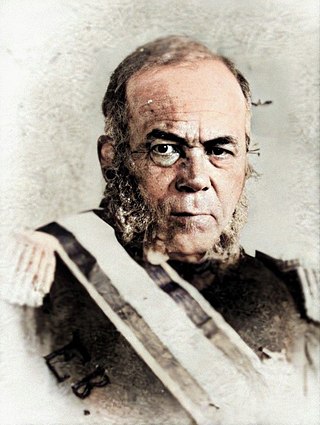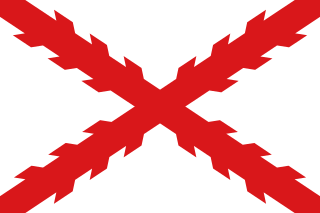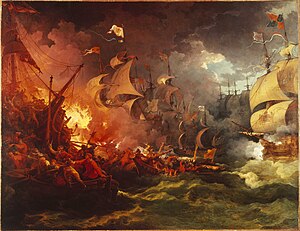
Tortuga Island is a Caribbean island that forms part of Haiti, off the northwest coast of Hispaniola. It constitutes the commune of Île de la Tortue in the Port-de-Paix arrondissement of the Nord-Ouest department of Haiti.

Pedro Santana y Familias, 1st Marquess of Las Carreras was a Dominican military commander and royalist politician who served as the president of the junta that had established the First Dominican Republic, a precursor to the position of the President of the Dominican Republic, and as the first President of the republic in the modern line of succession. A traditional royalist who was fond of the Monarchy of Spain and the Spanish Empire, he ruled as a governor-general, but effectively as an authoritarian dictator. During his life he enjoyed the title of "Libertador de la Patria."
Samaná English is a variety of the English language spoken by descendants of black immigrants from the United States who have lived in the Samaná Peninsula, now in the Dominican Republic. Members of the enclave are known as the Samaná Americans.

Samaná, in full Santa Bárbara de Samaná, is a town and municipality in northeastern Dominican Republic and is the capital of Samaná Province. It is located on the northern coast of Samaná Bay. The town is an important tourism destination and is the main center for whale-watching tours in the Caribbean region.

The Captaincy General of Santo Domingo was the first colony in the New World, established by Spain in 1492 on the island of Hispaniola. The colony, under the jurisdiction of the Real Audiencia of Santo Domingo, was granted administrative powers over the Spanish possessions in the Caribbean and most of its mainland coasts, making Santo Domingo the principal political entity of the early colonial period.

The Capture of Fort Rocher took place on 9 February 1654, during the Franco-Spanish War (1635–1659). Equipped with one siege battery, a Spanish expedition of 700 troops attacked the buccaneer stronghold of Tortuga, capturing the Fort de Rocher and 500 prisoners including 330 buccaneers and goods valued at approximately 160,000 pieces-of-eight. The Spanish burned the colony to the ground and slaughtered its inhabitants, leaving behind a fort manned by 150 soldiers. They possessed the island for about eighteen months, but on the approach of the expedition under Penn and Venables were ordered by the Conde de Peñalva, Governor of Santo Domingo, to demolish the fortifications, bury the artillery and other arms, and retire to his aid in Hispaniola.

The Providence Island colony was established in 1630 by English Puritans on Providence Island, about 200 kilometres (120 mi) east of the coast of Nicaragua. It was founded and controlled by a group of English investors, the Providence Island Company.
Ruy Fernández de Fuenmayor was a Spanish soldier who was governor of Venezuela Province between 1637 and 1644.
White Haitians, also known as Euro-Haitians, are Haitians of predominant or full European descent. There were approximately 20,000 whites around the Haitian Revolution, mainly French, in Saint-Domingue. They were divided into two main groups: The Planters and Petit Blancs. The first white Europeans to settle in Haiti were the Spanish. The Spanish enslaved the indigenous Haitians to work on sugar plantations and in gold mines. European diseases such as measles and smallpox killed all but a few thousand of the indigenous Haitians. Many other indigenous Haitians died from overwork and harsh treatment in the mines from slavery.

Juan de Canaveris was an Piedmontese lawyer and politician, who served during the viceroyalty of Río de la Plata as accounting officer in the Tribunal de Cuentas de Buenos Aires. He had achieved a high social status in the Viceroyalty of the Río de la Plata, where he supported the revolutionary movements of May, being the only neighbor of Italian origin who attended in the Open Cabildo, of May 22, 1810.

Marcio Veloz Maggiolo was a Dominican writer, archaeologist and anthropologist.
Manuel Alejandro Grullón Viñas is a businessman from the Dominican Republic. In April 2014, he was appointed the Chairman of Grupo Popular, a company whose subsidiaries include Banco Popular Dominicano, the largest private bank in the Dominican Republic. He has been president of the Banco Popular Dominicano since 1990. Forbes listed Grullón as one of the ten wealthiest men of the Dominican Republic.
Alejandro Enrique Grullón Espaillat was a banker and businessman from the Dominican Republic.

Martha Ellen Davis is an emeritus professor from the University of Florida, anthropologist and ethnomusicologist known for her multifarious work on African diasporic religion and music. Professor Davis' research has defied conventional tenets about Haitian and Dominican folk music, and her cultural preservation projects has raised awareness of the significance of the Samaná Americanos' enclave.

Campuzano-Polanco was a prominent family from the colony of Santo Domingo with origins in Santiago de los Caballeros. During the colonial era of the Hispaniola, their members and descendants went on to occupy high political, military and ecclesiastical positions, locally and outside the Island, as well as in the metropolis of Spain. Their merits extend since the beginning and until the end of the colony.

Felipe Alfau Mendoza was a Spanish military officer. He served as the first Spanish High Commissioner in Morocco and as Captain-General of Catalonia.

Dominican art comprises all the visual arts and plastic arts made in Dominican Republic. Since ancient times, various groups have inhabited the island of Ayíti/Quisqueya, or Hispaniola ; the history of its art is generally compartmentalized in the same three periods throughout Dominican history: pre-Hispanic or aboriginal Amerindian, Hispanic or colonial, and the national or Dominican period.

Peter Wallace is commonly held to have been an English or Scottish buccaneer who, in 1638 aboard the Swallow, founded the first English settlement in present-day Belize. Wallace's historicity is debated, first emerging in the 1829 Honduras Almanack; however, several scholars deem him a legendary protagonist of the country's founding myth, rather than an actual historical figure.

Brigadier General Manuel Nemesio Rodríguez Objío was a poet, newspaper founder, historian, army general, politician, martyr, and National Hero of the Dominican Republic.
Jeannette Miller is a writer, poet, narrator essayist and art historian of Dominican art. She was awarded the National Literature prize from her country in 2011.
















